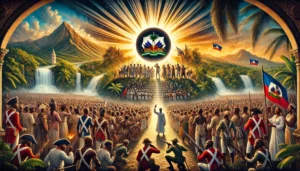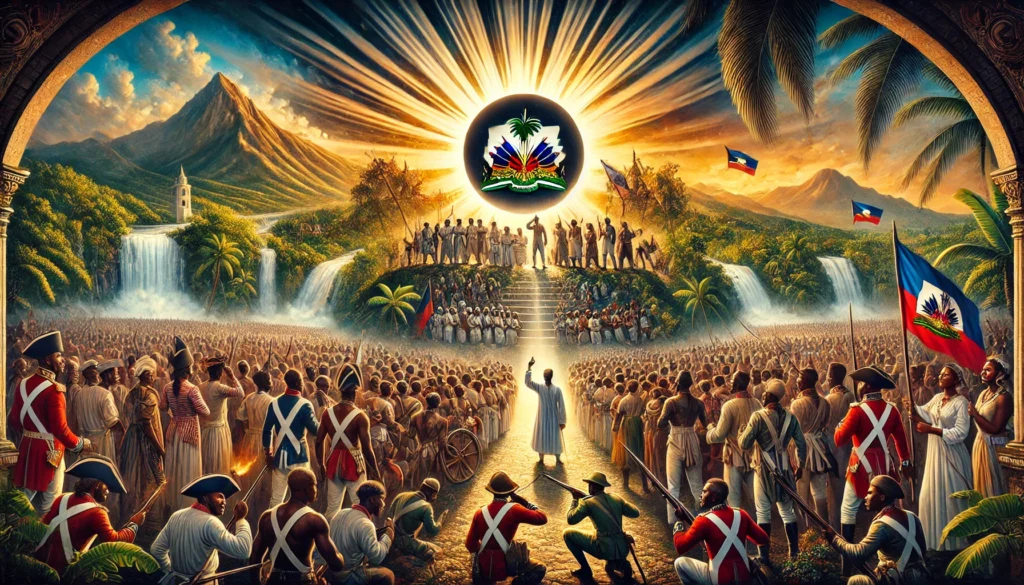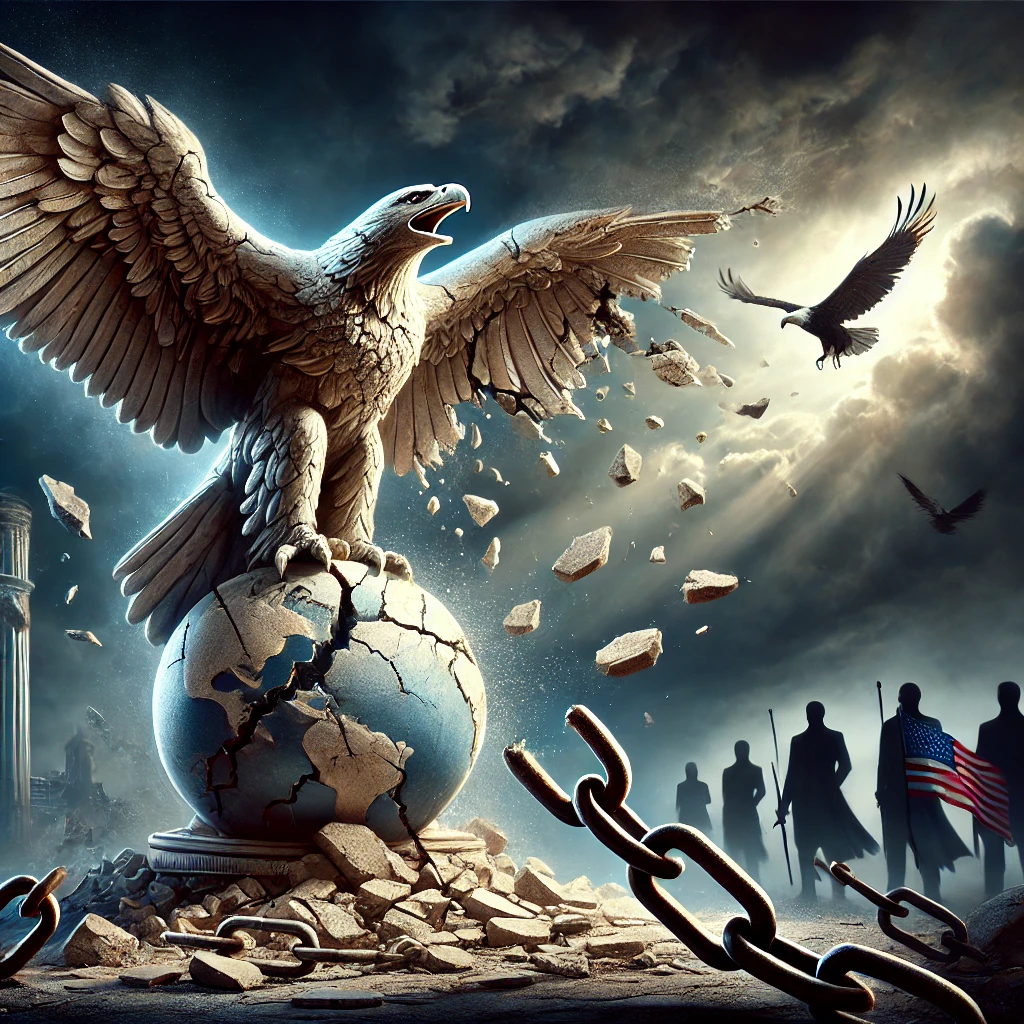THE BLACK LIGHT
Written by Radyo Makandal Sove on January 1, 2025
O Haitian (s), regardless of skin tone, religious belief, or political opinion, listen attentively; this is your story.
If essence of revolution is to bring forth individuals whose existence is obscured by the cast by oppressive power, or to make visible a mass kept in anonymity, then the Haitian revolution, bringing out of obscurity the majority of humanity that the supremacist order intended to keep indefinitely in abjection, is the first to truly deserve this name.
What is it about?
 From the clash of constitutive subjectivities in the chaotic universe of plantations, emerge emancipatory guiding principles, transcending the racialized slaves and humanity chained by the bonds of servitude. It is the Black Light of the subalterns, illuminating the path of which Aïti Quisqueya is the source, sometimes referred to as the beacon of the world to come sometimes as the matrix of freedom.
From the clash of constitutive subjectivities in the chaotic universe of plantations, emerge emancipatory guiding principles, transcending the racialized slaves and humanity chained by the bonds of servitude. It is the Black Light of the subalterns, illuminating the path of which Aïti Quisqueya is the source, sometimes referred to as the beacon of the world to come sometimes as the matrix of freedom.
This historical journey is also intended as a profound pilgrimage within oneself, to comprehend the various stages that lead from the stupefaction of slavery to the attainment of freedom. At every critical juncture of our collective journey, each individual must personally embark on the path that transition from the plantation, symbolizing the body of slave, to emancipation and liberation, epitomized by the glorious body of Makandal.
The destiny of the first black political sovereignty of modern times is to affirm the African black presence in the world, thereby “increasing the density and maturity of human consciousness.” To contemplate Haiti is to reflect on this alternative path, deviating from the anthropological drift induced by technological civilization, at the cost of unprecedented physical and symbolic violence that continues to devastate forms of life on the planet.
THE CRITICAL IMPASSE.
“Even when a society has managed to discover the path of the natural law that governs its movement, it can neither leap beyond nor abolish by decree the phases of its natural development.[1]”
It is true that Haitian crises are always unprecedented, each surpassing the previous one, and our history is marked by crossroads and turning points. However, we are currently experiencing a decisive moment that necessitates asking crucial questions, delving into the root of issues to examine not our forms of social organization, our institutional choices, our political biases, but the very meaning of our existence as a people.
This question pertains to the genesis of the Haitian people/nation, its metahistorical foundation, and seeks to elucidate the meaning of its presence in the world and its mode of inscription in history.
A nation is an entity shaped by historical perspectives, embodying all aspirations, whether conscious or unconscious, manifest or latent, at the foundation of its constitution.
In this sense, we adhere to the notion that it is the profound aspirations of women and men (whether acknowledged or overlooked in their connections with others) that shape and make history. Thus, only by understanding our mission can we validly understand the history of a nation, which is itself part of the broader history of humanity during a given cycle. Addressing the issue in isolation is of little interest and risks distorting it. Instead, It’s a holistic approach that encompasses all of humanity, through which destinies find their meaning. Modern science can yield partial truths through micro-histories, such as isolating a of for analysis, but we are aware of the limitations of this approach.
Approaching it in isolation is of little interest and risks distorting its essence. Rather, it is a matter of considering the totality, involving all of humanity within which destinies find its meaning. It is indeed possible, through modern science, to derive partial truths from micro-histories, such as isolating part of reality for analytical purposes; however, we are fully aware of the limitations of this method such as isolating a part of reality for analytical purposes.
Despite its diverse appearances, the species is united by a common destiny. From what totality do these singularities emerge? That is the fundamental question. Thus, there is unity of purpose amid the diverse paths of the grand human adventure.
Divergent interests, the degree of social harmony, socio-economic disparities, frequency of crises, and the stability and functionality of institutions, along with other factors, are simply part of how the mission is expressed. They crystallize, reflect, and translate into our physical reality the way in which this design is being realized. We can analyze the facts in their manifestation or in their essence. The best approach is to grasp them in their entirety, by revealing their essence in their manifestation. In any case, reality never fail to to bring us to the essence of things, by remaining irreducible to our limited external perception.
Collective construction is overdetermined by a system of meta-social guarantors, serving as a glue of integration and collective cohesion. This symbolic system is the expression of the nature of the historical mission of the community in question. The collective says its capacity to assume its destiny by the very fact of having been able to capture the message. But it is a potentiality to be actualized in time. In this very fact consists its history. Otherwise, it becomes an ahistorical entity that deviates from its course with all the social consequences that this implies.
The message delivered at Bwa Kay Imam is of this nature. Emphasizing the transcendent character of this call to freedom, Imam Boukman establishes it as a meta-social guarantor of the Ayisyen’s coexistence. It is said that the conforms to the inner disposition of the servant, through which he perceives Himself, to the truth. This is the case of the Messenger, who manifests himself through his message according to the capacity and intelligence of his community.
The authenticated hadith that encourages speaking to people based on their level of understanding is quite insightful on this topic. Moreover, consensus sometimes obscure the nuances and variations that naturally align with the message and its messenger. The changes we see don’t alter the essence; they only affect the form. Therefore, the outer layer reveals the circumstances and the core. The Messenger doesn’t address his community and humanity from the same perspective, nor does the one who sent him, the Lord of the worlds.
The Bwa Kay Imam ceremony marked the emergence of humanity of Ayisyen. It served as a resurrection for the Indigenous people affected by genocide and a liberation for Black community from the chains of slavery. This event represents a new, free entity, full of life and light. The entire universe acknowledges the arrival of this cosmic being, ushering in a new dimension of humanity and a different way of being in the world: the Ayisyen.
[1] Marx, Capital, Volume I, Part I.
 Radyo Makandal Sove
Radyo Makandal Sove 


